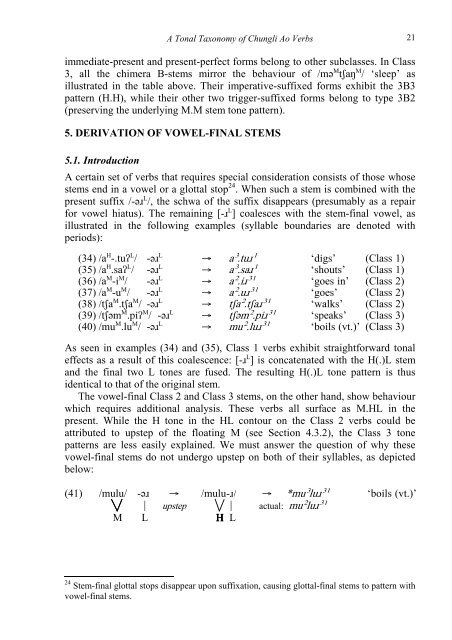A TONAL TAXONOMY OF CHUNGLI AO VERBS Daniel Bruhn ...
A TONAL TAXONOMY OF CHUNGLI AO VERBS Daniel Bruhn ...
A TONAL TAXONOMY OF CHUNGLI AO VERBS Daniel Bruhn ...
Create successful ePaper yourself
Turn your PDF publications into a flip-book with our unique Google optimized e-Paper software.
A Tonal Taxonomy of Chungli Ao Verbs<br />
immediate-present and present-perfect forms belong to other subclasses. In Class<br />
3, all the chimera B-stems mirror the behaviour of /mə M tʃaŋ M / ‘sleep’ as<br />
illustrated in the table above. Their imperative-suffixed forms exhibit the 3B3<br />
pattern (H.H), while their other two trigger-suffixed forms belong to type 3B2<br />
(preserving the underlying M.M stem tone pattern).<br />
5. DERIVATION <strong>OF</strong> VOWEL-FINAL STEMS<br />
5.1. Introduction<br />
A certain set of verbs that requires special consideration consists of those whose<br />
stems end in a vowel or a glottal stop 24 . When such a stem is combined with the<br />
present suffix /-əɹ L /, the schwa of the suffix disappears (presumably as a repair<br />
for vowel hiatus). The remaining [-ɹ L ] coalesces with the stem-final vowel, as<br />
illustrated in the following examples (syllable boundaries are denoted with<br />
periods):<br />
(34) /a H -.tuʔ L / -əɹ L → a³.tuɹ¹ ‘digs’ (Class 1)<br />
(35) /a H .saʔ L / -əɹ L → a³.saɹ¹ ‘shouts’ (Class 1)<br />
(36) /a M -i M / -əɹ L → a².iɹ³¹ ‘goes in’ (Class 2)<br />
(37) /a M -u M / -əɹ L → a².uɹ³¹ ‘goes’ (Class 2)<br />
(38) /tʃa M .tʃa M / -əɹ L → tʃa².tʃaɹ³¹ ‘walks’ (Class 2)<br />
(39) /tʃəm M .piʔ M / -əɹ L → tʃəm².piɹ³¹ ‘speaks’ (Class 3)<br />
(40) /mu M .lu M / -əɹ L → mu².luɹ³¹ ‘boils (vt.)’ (Class 3)<br />
As seen in examples (34) and (35), Class 1 verbs exhibit straightforward tonal<br />
effects as a result of this coalescence: [-ɹ L ] is concatenated with the H(.)L stem<br />
and the final two L tones are fused. The resulting H(.)L tone pattern is thus<br />
identical to that of the original stem.<br />
The vowel-final Class 2 and Class 3 stems, on the other hand, show behaviour<br />
which requires additional analysis. These verbs all surface as M.HL in the<br />
present. While the H tone in the HL contour on the Class 2 verbs could be<br />
attributed to upstep of the floating M (see Section 4.3.2), the Class 3 tone<br />
patterns are less easily explained. We must answer the question of why these<br />
vowel-final stems do not undergo upstep on both of their syllables, as depicted<br />
below:<br />
(41) /mulu/ -əɹ → /mulu-ɹ/ → *mu³luɹ³¹ ‘boils (vt.)’<br />
| upstep | actual: mu²luɹ³¹<br />
M L<br />
H L<br />
24 Stem-final glottal stops disappear upon suffixation, causing glottal-final stems to pattern with<br />
vowel-final stems.<br />
21

















